Leopard Lily, scientifically known as Iris domestica, is a captivating flowering plant that has found its way into the hearts of garden enthusiasts. With its unique spotted petals and graceful appearance, the Leopard Lily has become a sought-after addition to gardens around the world. In this comprehensive course, we will delve into the intricate details of caring for and cultivating Leopard Lilies, leaving no stone unturned.

Choosing the Right Location
Sunlight Requirements
Leopard Lily thrive in partial to full sunlight. Consider a location that receives morning sunlight and partial shade in the afternoon, protecting the plant from the harsh midday sun. If you’re unsure about the sunlight levels in your garden, use a sunlight meter to precisely measure the intensity in different areas.
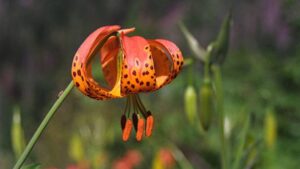
Soil Preferences for Optimal Growth
To create an ideal environment for Leopard Lily, prepare well-draining soil enriched with organic matter. Mixing in compost, peat moss, or well-rotted manure helps improve fertility and water retention. Conduct a soil pH test using a kit available at gardening stores to ensure it falls within the recommended range of 6.0 to 6.8.
Planting Leopard Lily
Ideal Planting Time
Timing is crucial when planting Leopard Lily. Choose early spring or early fall when the soil is workable. Follow these steps for successful planting:
- Dig a hole twice the width of the rhizome and deep enough to accommodate its size.
- Place the rhizome horizontally in the hole, ensuring the roots face downward.
- Cover the rhizome with soil, leaving the top exposed.
- Water thoroughly to settle the soil.

Proper Planting Depth and Spacing
Maintaining the correct planting depth and spacing is vital for the health of Leopard Lily. Plant rhizomes at a depth of 1-2 inches, ensuring they are not buried too deep. Space multiple plants 12-18 inches apart to prevent overcrowding, allowing for proper air circulation.
Watering and Moisture
Regular Watering Schedule
Establishing a consistent watering schedule is key to keeping Leopard Lily healthy. Water deeply once a week, ensuring the soil remains consistently moist but not waterlogged. Use a soaker hose or drip irrigation system to deliver water directly to the roots, avoiding wetting the foliage.
Tips for Maintaining Proper Soil Moisture
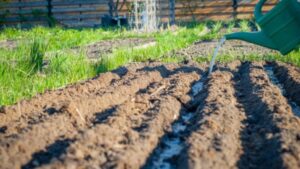
Mulching serves as a valuable tool for moisture retention. Apply a layer of organic mulch, such as bark chips or straw, around the base of the plants. This not only helps regulate soil temperature but also suppresses weeds that might compete for water.
Additionally, consider investing in a rain gauge to monitor natural rainfall. Adjust your watering schedule accordingly, providing supplemental irrigation during dry spells.
Fertilization Techniques
Appropriate Fertilizers for Leopard Lily
Choosing the right fertilizer is crucial for Leopard Lily health. Opt for a balanced, slow-release fertilizer with equal parts nitrogen, phosphorus, and potassium (N-P-K). A granular fertilizer with a ratio of 10-10-10 or 14-14-14 works well. Avoid high-nitrogen fertilizers, as they may encourage excessive foliage growth at the expense of flowering.
Timing and Frequency of Fertilizing
Fertilize Leopard Lily in early spring before new growth emerges. Repeat the application every 4-6 weeks during the growing season, stopping in late summer to allow the plant to prepare for dormancy. Water the plants after fertilizing to help nutrients reach the roots.
Remember, moderation is key when fertilizing Leopard Lily. Over-fertilization can lead to nutrient imbalances and adversely affect the plant’s overall health.
Pruning and Maintenance
Trimming and Deadheading for Healthy Growth
Pruning and deadheading play crucial roles in maintaining the aesthetic appeal of Leopard Lily. Follow these steps:

- Use clean, sharp pruning shears to trim dead or yellowing leaves at their base.
- Deadhead spent blooms regularly, cutting the flower stalk just above a healthy leaf.
- Remove any damaged or diseased foliage promptly to prevent the spread of infections.
Pruning not only enhances the plant’s appearance but also encourages the development of new shoots and blooms.
Addressing Common Issues and Diseases
Leopard Lily are generally resilient, but they may encounter pests and diseases. Keep an eye out for aphids, spider mites, and fungal infections. Treat pest problems with insecticidal soap or neem oil, and use fungicides if necessary. Regular inspections and prompt action contribute to a thriving, disease-free garden.
Blooming and Flowering Period
Information on Typical Blooming Season
Leopard Lily typically bless your garden with their enchanting blooms in late spring to early summer. The vibrant, spotted flowers make a stunning display, attracting attention and admiration. To maximize your enjoyment of this blooming period, consider the following:
- Optimal Conditions: Ensure your Leopard Lily receive the right amount of sunlight and water during the blooming season.
- Continuous Care: Continue your regular care routine, including watering and fertilizing, to support ongoing blooming.
Tips to Encourage Prolonged Flowering
To extend the blooming period and revel in the beauty of Leopard Lily for a more extended duration, follow these helpful tips:
- Deadheading: As flowers begin to fade, promptly deadhead them to redirect the plant’s energy into producing new blooms.
- Consistent Moisture: Maintain a consistent watering schedule to prevent stress on the plants, allowing them to focus on flowering.
- Fertilization: Apply a diluted, balanced fertilizer during the blooming season to provide essential nutrients for flower production.
Attracting Wildlife
How Leopard Lily Can Attract Pollinators
Leopard Lily act as natural magnets for pollinators, including bees and butterflies. Enhance the biodiversity of your garden by creating an environment that encourages these essential insects. Here’s how:
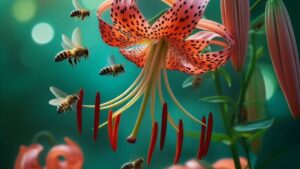
- Plant Diversity: Surround your Leopard Lily with a variety of flowering plants to attract a broad range of pollinators.
- Avoid Pesticides: Minimize the use of chemical pesticides that may harm beneficial insects.
Supporting Biodiversity in Your Garden
Beyond pollinators, Leopard Lily contribute to a thriving ecosystem. By maintaining a healthy garden, you support beneficial insects that control pests and create a balanced, sustainable environment. Embrace a holistic approach to gardening that goes beyond aesthetics and considers the broader ecosystem.
Container Gardening
Guidelines for Growing Leopard Lily in Pots
Container gardening offers flexibility for those with limited space or a preference for portable plants. Follow these steps to successfully grow Leopard Lilies in containers:
- Choose the Right Container: Select a spacious container with drainage holes to prevent waterlogging.
- Quality Potting Mix: Use a well-draining potting mix enriched with organic matter.
- Planting Depth: Place the rhizomes at the same depth as in the ground, ensuring they are not buried too deep.
Choosing the Right Container and Soil Mix
Consider the following when selecting containers and soil mix for Leopard Lilies:
- Container Size: Opt for a container that allows for proper root development and accommodates the growth of Leopard Lilies.
- Drainage: Ensure the container has adequate drainage holes to prevent water accumulation.
- Soil Composition: Mix a balanced potting soil with perlite or sand to improve drainage and aeration.
Container gardening provides the flexibility to move your Leopard Lilies for optimal sunlight and aesthetic arrangement.
Propagation Techniques
Methods for Propagating Leopard Lilies
Propagating Leopard Lilies allows you to expand your collection or share these beautiful plants with friends. Here are two effective methods for Leopard Lily propagation:
- Division: Every 3-4 years, divide mature Leopard Lily clumps in early spring or fall.
- Steps:
- Dig up the entire clump, being careful not to damage the rhizomes.
- Separate the rhizomes into sections, each containing healthy roots and at least one growing point.
- Replant the divisions at the appropriate depth and spacing.
- Steps:
- Rhizome Cuttings: Propagate Leopard Lilies by taking rhizome cuttings.
- Steps:
- Cut healthy rhizomes into sections, each about 4-6 inches long, ensuring each section has at least one bud.
- Plant the rhizome cuttings horizontally in well-draining soil.
- Keep the soil consistently moist until new growth emerges.
- Steps:
Successful propagation relies on providing the right conditions for the new plants to establish themselves. Regular monitoring and care ensure a higher success rate.
Companion Planting
Plants that Complement Leopard Lilies
Enhance the visual appeal of your garden by strategically choosing companion plants that complement Leopard Lilies. Consider the following combinations:
- Daylilies (Hemerocallis): Pairing Leopard Lilies with daylilies creates a striking contrast in flower shapes and colors.
- Salvia: The vibrant hues of salvias provide a stunning backdrop to the spotted blooms of Leopard Lilies.
- Hostas: The lush foliage of hostas complements the vertical growth of Leopard Lilies, creating a harmonious display.
When planning your garden, think about the height, color, and bloom time of neighboring plants to create a balanced and aesthetically pleasing arrangement.
How to Care for a Leopard Lily? Seasonal Care
Specific Care Requirements During Different Seasons
Spring
- Fertilize: Apply a balanced fertilizer as new growth begins. Keep the soil consistently moist but not waterlogged to promote healthy growth.
- Divide: If necessary, divide and transplant Leopard Lilies in early spring. Remove any dead or damaged foliage to allow for new growth to thrive. Monitor for pests and diseases, and treat accordingly to ensure the health of your Leopard Lilies.
Summer
- Watering: Maintain consistent watering, especially during hot and dry spells. Water deeply to reach plant roots. Use a soaker hose or drip system for even watering. Mulch to retain moisture. Adjust watering based on weather and plant needs.
- Deadheading: Continue deadheading spent blooms to encourage continuous flowering. Remember to remove any faded or wilted flowers regularly to redirect the plant’s energy into producing new blooms. This simple task can make a big difference in the overall appearance and longevity of your flowering plants.
Fall
- Cut Back: Trim back foliage as Leopard Lilies enter dormancy.
- Mulch: Apply a layer of mulch around the plants to protect against winter cold.
Winter
- Protection: In colder climates, consider providing additional protection with a layer of straw or leaves.
Adapting your care practices ensures Leopard Lilies remain resilient and ready to thrive in the coming growing season.
Leopard Lily Varieties
Overview of Popular Leopard Lily Varieties
Explore the diverse world of Leopard Lilies by considering these popular varieties, each offering unique characteristics and visual appeal:
- ‘Black Gamecock’: Known for its deep purple, almost black, flowers and striking foliage. Black Gamecock is a stunning addition to any garden, providing a bold pop of color and unique texture. This variety of iris is sure to make a statement with its dark, dramatic blooms that are sure to stand out in any landscape. With its vibrant hues and eye-catching appearance, Black Gamecock is a must-have for any gardener looking to add a touch of sophistication to their outdoor space.
- ‘Excelsa’ (Peacock Orchid): Features elegant white blooms with contrasting burgundy spots. This variety of orchid is known for its striking beauty and unique coloration. The ‘Excelsa’ Peacock Orchid is a stunning addition to any garden or floral arrangement, adding a touch of elegance and sophistication. With its delicate white petals and eye-catching burgundy spots, this orchid is sure to be a standout feature in any setting. Whether displayed on its own or mixed with other flowers, the ‘Excelsa’ Peacock Orchid is a true showstopper.
- ‘Pardancanda norrisii’ (Candy Lily): A hybrid with bi-colored flowers resembling a candy cane. The Candy Lily is a stunning addition to any garden, with its unique bi-colored blooms adding a pop of color and whimsy. Its resemblance to a candy cane makes it a playful and eye-catching choice for flower beds or borders. Easy to care for and sure to attract attention, ‘Pardancanda norrisii’ is a must-have for any plant enthusiast looking to add a touch of fun to their outdoor space.

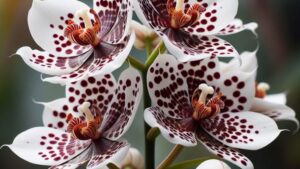
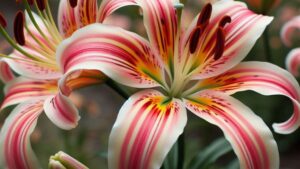
Understanding the distinctive features of each variety allows you to curate a garden with a mix of Leopard Lilies that captivate and intrigue.
Landscaping Ideas
Incorporating Leopard Lilies into Various Garden Designs
Integrate Leopard Lilies seamlessly into your garden with these creative landscaping ideas:
- Mixed Borders: Plant Leopard Lilies at the edges of mixed borders to add texture and color.
- Rock Gardens: Use Leopard Lilies as focal points in rock gardens, surrounded by low-growing companion plants.
- Containers and Pots: Elevate your patio or deck by placing Leopard Lilies in decorative containers for a stunning display.
Experimenting with different placements and combinations allows you to discover the most aesthetically pleasing arrangements for your garden.
Conclusion
Cultivating Leopard Lilies is a rewarding endeavor that brings a touch of elegance and vibrancy to any garden. By adhering to the comprehensive care guidelines provided in this article, you ensure the health and longevity of these captivating plants. Whether you’re a seasoned gardener or just starting, Leopard Lilies offer a delightful and manageable addition to your outdoor space.
Now, armed with the knowledge of their preferences, you can confidently nurture and enjoy the beauty of Leopard Lilies throughout the seasons. Remember to adapt your care routine to the changing needs of the plants, creating an environment where they can thrive and flourish.
Get ready to witness your garden transform into a haven of spotted blooms, attracting pollinators and adding a touch of nature’s artistry to your surroundings.
FAQs
Are Leopard Lilies suitable for novice gardeners?
Absolutely! Leopard Lilies are hardy and relatively easy to care for, making them an excellent choice for beginners.
Can Leopard Lilies be grown indoors?
While they prefer outdoor conditions, Leopard Lilies can be grown in large, well-lit indoor spaces, such as conservatories or sunny atriums.
Are Leopard Lilies resistant to pests and diseases?
Leopard Lilies are generally resilient but may encounter aphids and spider mites. Regular monitoring and prompt action can prevent and manage these issues.
Can I plant different varieties of Leopard Lilies together?
Yes, planting different varieties together can create a visually stunning garden with a variety of colors and patterns.
Do Leopard Lilies have a specific blooming season?
Leopard Lilies typically bloom in late spring to early summer, providing a spectacular display of spotted flowers.
